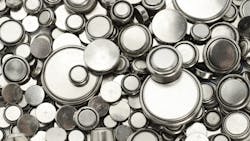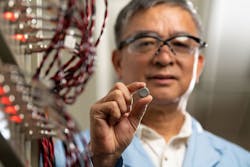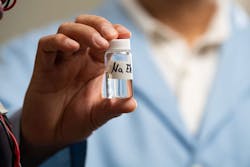The research is a work in progress, but scientists at the Department of Energy’s Pacific Northwest National Laboratory have developed a sodium-ion battery that holds promise for large-scale applications.
The ingredients that make up the liquid core of the new battery have been adjusted, which resulted in extended longevity in lab tests, reported the research team in a press release.
“Here, we have shown in principle that sodium-ion batteries have the potential to be a long lasting and environmentally friendly battery technology,” noted PNNL lead author Jiguang (Jason) Zhang, a pioneer of battery technologies with more than 23 patented inventions in energy storage technology.
Tweaking the Ingredients
In batteries, the electrolyte is the chemical medium that facilitates the flow of electrical charge between the cathode and anode. The researchers explained that the electrolyte forms by dissolving salts in solvents. The resulting charged ions flow between the positive and negative electrodes. However, electromechanical reactions that cause the energy to flow will slow down over time, thereby hindering the ability to recharge.
Sodium-ion batteries are typically limited by this shortcoming and are disadvantaged relative to similar lithium-ion batteries.
READ MORE: New Research Looks to Improve Safety of Battery Technology
Sodium Solution
The research team replaced the liquid solution and the type of salt flowing through it. Lab tests have shown durable results. The new design can hold 90% of its cell capacity after 300 cycles at 4.2 V, which is higher than most sodium-ion batteries previously reported, according to the PNNL team led by scientists Yan Jin and Phung Le.
The press release noted that the current electrolyte recipe for sodium-ion batteries results in the protective film on the negative end (the anode) dissolving over time. This film is critical because it allows sodium ions to pass through while preserving battery life. The researchers noted that the new electrolyte works by stabilizing this protective film and also generates an ultra-thin protective layer on the positive pole (the cathode) that contributes to additional stability of the entire unit.
Non-flammable Form Factor
A few other enhancements have sprung from the new PNNL-developed sodium-ion technology. The battery uses a “naturally fire-extinguishing solution” that is unaffected by temperature fluctuations and can operate at high voltages. The researchers explained that the ultra-thin protective layer remains stable once formed, which contributes to the long cycle life.
“We also measured the production of gas vapor at the cathode,” said Phung Le, a PNNL battery chemist. “We found very minimal gas production. This provides new insights to develop stable electrolyte for sodium-ion batteries that may operate at elevated temperatures.”
READ MORE: dSPACE Launches Modular Testing Concept for Battery Management Systems
What’s the Rub?
Even though sodium-ion technology still lags behind lithium in energy density, it does have its advantages. The researchers point to the fact that it is impervious to temperature changes, stability and long cycle life. These are valuable for applications of certain light-duty electric vehicles and even grid energy storage in the future, they said.
But the new PNNL-developed sodium-ion design isn’t home-free yet. The researchers will need to refine their design; they have a few ambitions before the battery can get a stamp of approval. For one, the research team wants to figure out how to reduce or possibly eliminate the need to use of cobalt, a toxic and costly material.
Given the current progress, their objectives could very well be in the realm of possibilities.
The team of researchers published their findings in the journal Nature Energy.
This article appeared in Machine Design.



